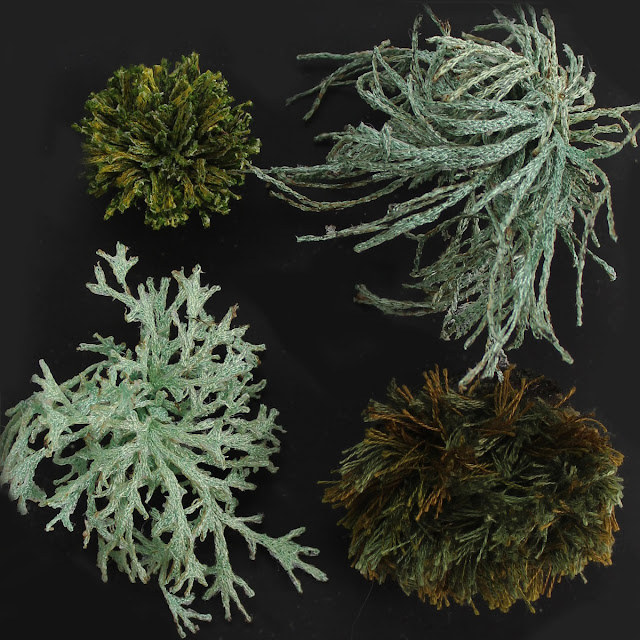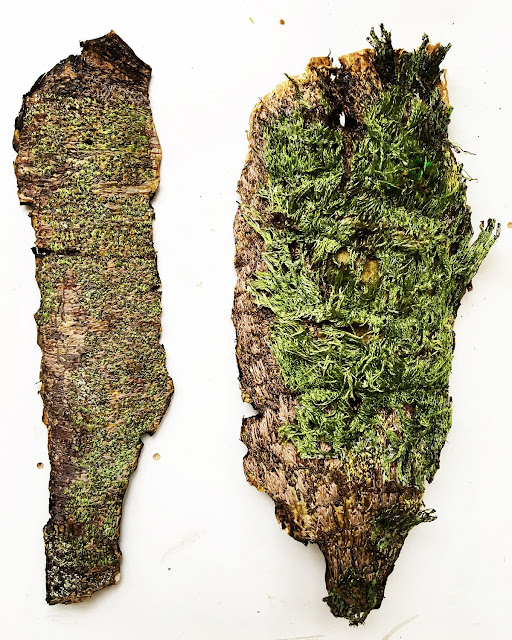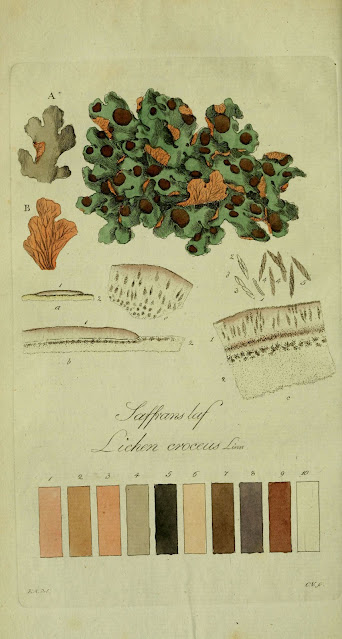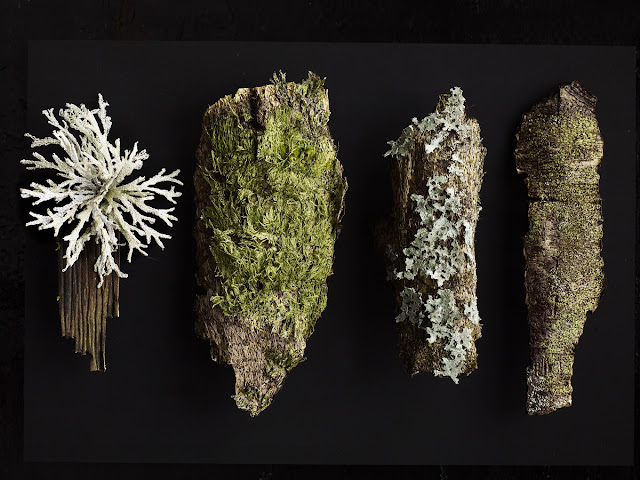Lichen is a strange and beautiful life form, or rather a mutualistic relationship between algae or Cyanobacteria and fungi to make a composite organism. They have different shapes, sizes, parts, colours and somehow have properties which differ from those of their component parts. Like plants they photosynthesize, but they have no roots. I recall learning as a child how they were the trailblazers, making their home on the rocks of the Canadian Shield, and allowing a succession of other organisms to grow on top, till we have large trees which appear to grow straight out of the rock, but without lichen it could not be there. When lichen grows on trees it is not a parasite, it just uses plants as a surface on which to grow. They grow in a huge range of environments, even tundra, deserts, mountains and rainforests on virtually any convenient surface. Scientists estimate 6 to 8% of the Earth's land surface is covered by lichen, and yet we can walk right by without giving it a second thought.
Some though, have long admired lichen, especially its extraordinary colour palette and variety of textures and forms. This is a selection of the colour charts based on lichen from the Svensk Lafvarnas Farghistoria by Johan Peter Westring. Printed in 1805-09. Via the Biodiversity Heritage Library archive.
![Svenska lafvarnas färghistoria Stockholm :Tryckt hos C. Delén,1805-[1809] Svenska lafvarnas färghistoria Stockholm :Tryckt hos C. Delén,1805-[1809]](https://blogger.googleusercontent.com/img/a/AVvXsEhwJMIIpaeBuk7HzhSebtNw8BJ0R8W7ou1p_YpzhO3CQUZqFrO-9aMeEWjJU_eh-3gazSowFNfctjM8WDyDBxrc2Pu8uq-gFYLjJ6NbfQeaBC7ymw2QK8WeQgvailfccIrtuYdcAM8q-p0VyI0WpPmwg0DPvWQVzxcWAfGXy0ia7KYeYs5BzfT1GFE2=w344-h640)
One of my favourite lichen artists is Dr. Immy Smith (
website,
Etsy,
Patreon). They make a wide variety of artwork, much of it about natural history, or drawing on their background in neuroscience, but clearly they love lichen and have observed it very closely.
 |
| 'Lichen makes the landscape' - Immy Smith with Herbarium RNG curators |
They collaborated on the 'Symbiosis' project as part of the part of the Imagining Science Polymathic Art & Science Collaborative, with fellow member Scott Mantooth and other artists, scientists and the University of Reading Herbarium and EM Lab (Centre for Advanced Microscopy). Other drawings illustrate scanning electron microscope images of lichen. You can read more here.
 |
| 'Reading campus twig' - Immy Smith with Herbarium RNG curators |
UK textile artist
Amanda Cobett makes papier maché and machine embroidered sculptures, often fungi and extraordinarily life-like lichen.
 |
| Amanda : Moss and Lichen TQ 085 439, 2018, Built up layers of free machine embroidery (Photo credit, Fraser James) |
 |
| Amanda Cobbett: Moss, bark and Lichen detail TQ 085 44, 2018, Built up layers of free machine embroidery, materials used; paper, silk, thread, dye, backing cloth, (Photo credit, Fraser James) |
Artist and researcher
Sarah Hearn makes artworks inspired by biology.
She has made several lichen-inspired series of artworks.
 |
| Sarah Hearn, Artificial Lichen Colony #8 10" x 15" cut photographs and watercolor, 2015 |
 |
| Sarah Hearn, Artificial Lichen Colony Collage #5 42" x 24" cut photographs, watercolor and graphite, 2016 (private commission) |
 |
| Sarah Hearn, Artificial Lichen Colony #6 15" x 10" cut photographs and watercolor, 2016 |
There are whole worlds to contemplate in these extraordinary things if only we stop to look.






![Svenska lafvarnas färghistoria Stockholm :Tryckt hos C. Delén,1805-[1809] Svenska lafvarnas färghistoria Stockholm :Tryckt hos C. Delén,1805-[1809]](https://blogger.googleusercontent.com/img/a/AVvXsEhwJMIIpaeBuk7HzhSebtNw8BJ0R8W7ou1p_YpzhO3CQUZqFrO-9aMeEWjJU_eh-3gazSowFNfctjM8WDyDBxrc2Pu8uq-gFYLjJ6NbfQeaBC7ymw2QK8WeQgvailfccIrtuYdcAM8q-p0VyI0WpPmwg0DPvWQVzxcWAfGXy0ia7KYeYs5BzfT1GFE2=w344-h640)













No comments:
Post a Comment